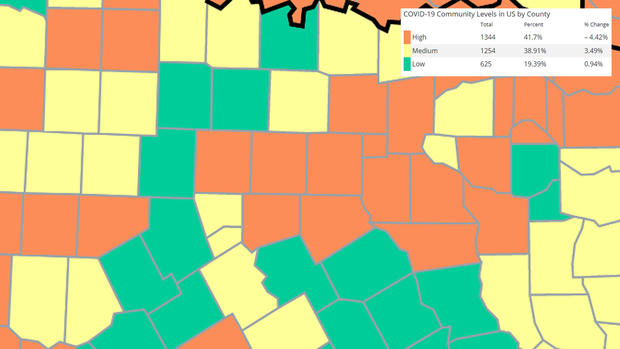CDC updates its COVID-19 guidelines in sweeping overhaul
WASHINGTON (CBSDFW.COM) — The Centers for Disease Control and Prevention unveiled significant changes Thursday as part of a sweeping effort to overhaul the agency's COVID-19 guidance.
The changes come as new, highly contagious variants spread rapidly through the country. In many North Texas counties, the CDC says, transmission levels are high. That includes Tarrant, Dallas, Collin, Parker, Johnson, Ellis, Kaufman, Rockwall, Hunt, Van Zandt, and Henderson Counties.
"This guidance acknowledges that the pandemic is not over, but also helps us move to a point where COVID-19 no longer severely disrupts our daily lives," CDC's Greta Massetti said in a statement announcing the changes.
Among the biggest differences in the new recommendations: the CDC's COVID-19 prevention guidance will no longer differentiate by whether people are up-to-date on their vaccinations.
Testing to screen for COVID-19 will no longer be recommended in most places for people who do not have COVID symptoms.
And the CDC says that "to limit social and economic impacts, quarantine of exposed persons is no longer recommended, regardless of vaccination status."
Massetti told reporters Thursday that the recommendations are being revised to simplify the myriad of federal COVID-19 guidance into an easier "framework."
"There isn't a lot in our package of guidance that's new, really. What's new is presenting it as a framework, and how we're messaging the updates," said Massetti.
"It's really about kind of how people can understand how all of these components fit together. It starts with people understanding their own personal risk, for serious illness, and that of their loved ones."
The agency will also trim out several specific COVID-19 recommendations for schools, like guidance around "cohorting" or the "test to stay" strategy where students exposed to the virus could remain in school as long as they continued to test negative.
"The key changes in the school guidance are in those sections that would parallel the changes in the community guidance. So, for example, we are no longer recommending quarantine. And so in the school guidance, there is no more section on quarantine," Massetti told reporters.
A summary of the changes was published Thursday in the agency's Morbidity and Mortality Weekly Report.
Detailed recommendations are expected to be updated and "streamlined" over the coming days, including for travel, nursing homes, and other high-risk congregate settings.
Nursing and health care settings will continue to rely on the agency's old community transmission framework, Massetti said, which is based on counts of reported COVID-19 cases.
The rest of the agency's guidance will continue to be pegged to the CDC's COVID-19 Community Levels benchmarks, which incorporate hospitalization figures into determining whether counties are at "low," "medium," or "high" levels of the disease.
Massetti said the agency is continuing to reassess the performance of those metrics, but for now the agency has not "gotten any results that suggest a substantial change is warranted at this time."
The CDC's COVID-19 officials have telegraphed plans to significantly revise and simplify the guidelines for months, acknowledging growing fatigue with measures aimed at curbing the virus and the changing threat posed by it more than two and a half years into the pandemic.
"We have high levels of vaccine and infections-induced immunity in the country, we have highly effective treatments and prevention tools, we've greatly reduced the risk of medically significant illness, hospitalization, and death," Dr. Ian Williams, head of the agency's COVID-19 response, said this week at a meeting of the agency's outside advisers.
Williams said the CDC has also moved over recent months to wind down a substantial share of its standalone pandemic response, integrating its COVID-19 activities into the agency's regular teams.
The shift comes as the latest COVID-19 wave appears to now be subsiding, after hospitalization rates reached some of the worst levels seen since the winter Omicron surge.
Deaths remain around 400 per day on average — far lower than some of the worst peaks during previous waves, though still a level that makes it one of the nation's leading causes of death. .
"This is about pivoting our public health focus on sustainable efforts to minimize the impact of COVID-19 on health and society," Williams added.




